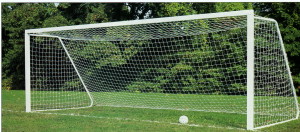 It’s right there in soccer’s Law 1, the Field of Play: “Goals must be securely anchored to the ground. Portable goals may only be used if they satisfy this requirement.”
It’s right there in soccer’s Law 1, the Field of Play: “Goals must be securely anchored to the ground. Portable goals may only be used if they satisfy this requirement.”
There’s a pretty simple reason for this. A goal, especially older-style metal ones with bars five inches wide, can weigh several hundred pounds. Much of the heft is centered in the crossbar across the top front (under which, in the sparse words of soccer’s great Law 10, the ball must pass under for a score to count). This top-heavy characteristic can make an unanchored goal unstable, and prone to tipping forward if struck by a player or caught by a gust of wind. And maybe seriously injuring a player–or worse. On average, one player a year, usually around the age of 10, gets killed by a falling goal just in North America alone.
But I guess the word hasn’t gotten out completely, even among referees whose job it is to inspect the goals before a match. For 10 days ago, New York State Governor Andrew Cuomo signed into a law a bill requiring “safety standards for anchoring, securing and counter-weighting a movable soccer goal.”
New York is not the first state to enact such a law; Wisconsin did so four years ago. But the fact that lawmakers felt it necessary to get involved is not a terrific commentary on certain leadership corners of youth soccer.
As is so often the case, the new law was prompted by a real-life incident. In 2002 an 8-year-old girl by the name of Julia Parisi from the upscale New York City suburb of Rye Brook suffered a crushed femur when she was hit by a portable goal knocked over by wind as she was warming up for a match. She recovered, but her incident, cited in the legislative history of the bill, got the ball rolling, so to speak.
The new law orders a state agency to come up with mandatory rules within six months, based on guidelines promulgated way back in 1995 by the U.S. Consumer Product Safety Commission. Violators can be hit with a civil penalty of $500 for each defective goal, but only the state Attorney General can bring a case, pretty much insuring that there won’t be very many.
The 12-page CPSC document, entitled “Guidelines for Movable Soccer Goal Safety,” is full of helpful diagrams. For the increasing number of soccer fields made of artificial turf, sandbags over the ground supports of a goal are recommended.
But one passage caught my eye. “The majority of incidents investigated by CPSC did not occur during a soccer match. Most of the incidents occurred when the goals were unattended.” That is to say, by kids playing pick-up soccer on fields where movable goals were left after the organized leagues left. In my experience as a soccer referee for 17 years across three states, that happens a lot, especially on fields used for other sports, like baseball and softball, where a permanently affixed goal along the right-field line can really get in the way.
It is not at all clear to me that the new New York State law would reach such unorganized soccer matches unless the AG’s office wants to start seeking financial penalties from the kid who, in the law’s wording, “erects” the goal.
The CPSC guidelines recommend that movable goals be locked up on the side when unused for organized play. But that likely would discourage use of fields on a casual basis, when no coaches, referees or even parents are around. Now, I think I’d rather have kids in the ‘hood playing soccer than doing who knows what elsewhere. To my thinking, the solution is movable soccer goals designed with all the weight at the bottom such that it is virtually impossible for them to tip over and thus they are as good as anchored. No reason soccer and safety can’t be synonymous.

Thanks for your attention to this 25 year travesty. The CPSC and ASTM have been part of the problem and not part of the solution! Since they got involved in 1990, more kids have died. The only solution is to permanently attach weighted rollers to the rear of the goal that make every goal in America safe and portable.